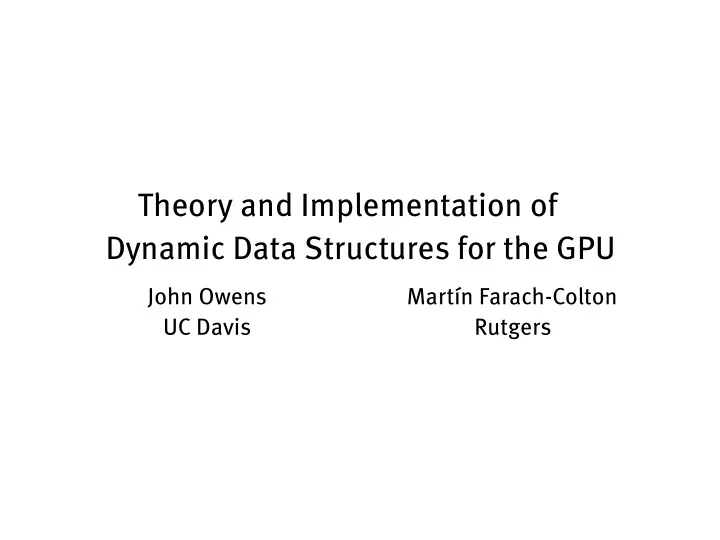

Theory and Implementation of Dynamic Data Structures for the GPU John Owens Martín Farach-Colton UC Davis Rutgers
NVIDIA OptiX & the BVH Tero Karras. Maximizing parallelism in the construction of BVHs, octrees, and k - d trees. In High-Performance Graphics , HPG ’12, pages 33–37, June 2012.
The problem • Many data structures are built on the CPU and used on the GPU • Very few data structures can be built on the GPU • Sorted array • (Cuckoo) hash table • Several application-specific data structures (e.g., BVH tree) • No data structures can be updated on the GPU
Scale of updates • Update 1–few items • Fall back to serial case, slow, probably don’t care • Update very large number of items • Rebuild whole data structure from scratch • Middle ground: our goal • Questions: How and when?
Approach • Pick data structures useful in serial case, try to find parallelizations? • Pick what look like parallel-friendly data structures with parallel-friendly updates?
Log-structured merge tree merge . Michael A. Bender, Martin Farach-Colton, Jeremy T. Fineman, Yonatan R. Fogel, Bradley C. Kuszmaul, and Jelani Nelson. 2007. Cache-oblivious Streaming B-trees . In Proceedings of the Nineteenth 2 1 0 2 1 0 2 1 0 Annual ACM Symposium on Parallel Algorithms and Architectures (SPAA ’07). 81–92. • Supports dictionary and range queries • log n sorted levels, each level 2x the size of the last • Insert into a filled level results in a merge, possibly cascaded. Operations are coarse (threads cooperate).
LSM results/questions • Update rate of 225M elements/s • 13.5x faster than merging with a sorted array • Lookups: 7.5x/1.75x slower than hash table/sorted array • Deletes using tombstones • Semantics for parallel insert/delete operations? • Minimum batch size? • Atom size for searching? • Fractional cascading? Saman Ashkiani, Shengren Li, Martin Farach-Colton, Nina Amenta, and John D. Owens. GPU COLA: A dynamic dictionary data structure for the GPU . January 2017. Unpublished.
Quotient Filter 0 1 2 3 4 5 6 7 8 9 • Probabilistic a c f g f q f f r A 1 a B 1 b b d h C 3 c D 3 d membership queries E 3 e e F 4 f G 6 g & lookups: false H 6 h is_continuation is_shifted cluster is_occupied run positives are 0 1 2 3 4 5 6 7 8 9 0 0 0 1 0 0 0 1 1 1 0 0 1 1 1 0 1 1 1 0 1 0 0 1 0 1 1 0 0 0 a b c d e f g h possible . Michael A. Bender, Martin Farach-Colton, Rob • Comparable to a Johnson, Russell Kraner, Bradley C. Kuszmaul, Dzejla Medjedovic, Pablo Montes, Bloom filter but also Pradeep Shetty, Richard P. Spillane, and Erez Zadok. 2012. Don’t Thrash: How to Cache supports deletes and Your Hash on Flash . Proceedings of the VLDB Endowment 5, 11 (Aug. 2012), 1627–1637. merges
QF results/questions • Lookup perf. for point queries: 3.8–4.9x vs. BloomGPU • Bulk build perf.: 2.4–2.7x vs. BloomGPU • Insertion is significantly faster for BloomGPU • Similar memory footprint • 3 novel implementations of bulk build + 1 of insert • Bulk build == non-associative scan • Limited to byte granularity Afton Geil, Martin Farach-Colton, and John D. Owens. GPU Quotient Filters: Approximate Membership Queries on the GPU . January 2017. Unpublished.
Cross-cutting issues • Useful models for GPU memory hierarchy • Independent threads vs. cooperative threads? • More broadly, what’s the right work granularity? • Memory allocation (& impact on hardware) • Cleanup operations, and programming model implications • Integration into higher-level programming environments • Use cases! Chicken & egg problem
Recommend
More recommend